It’s the only house of its kind off Metro-North. Among its nearly two dozen rooms, it boasts seven bedrooms, three bathrooms, two kitchens, a wine cellar, a triangular solarium, and an Egyptian-themed music room, as well as a wraparound veranda, a conservatory greenhouse, and a massive dome atop it all. Oh, and it might be haunted.
Welcome to the Armour-Stiner Octagon House, a 19th-century architectural marvel and one of New York’s most strange and eccentric attractions, once described by the NY Times as “the Taj Mahal of the Hudson Valley.” Built in 1860 and redesigned in 1872 to resemble a Roman temple, the house is one of the few surviving examples of an octagonal dwelling, and it’s the only fully domed octagonal home in existence. Owned by the family that bought the house in 1978 and saved it from collapse, it stands today as fantastical museum to the whims and eccentricities of its owners, and as an aesthetic delight full of surprises. And best of all, you can reach it via Metro-North.
The House’s History

The Armour-Stiner Octagon House was the brainchild of Paul Armour, a New York City financier, who took his inspiration from a man named Orson Squire Fowler, an amateur architect who in 1848 published a book called The Octagon House: A Home For All. Fowler — who was among other things a sexologist, a phrenologist, and an early animal rights activist and vegetarian — believed that octagon-shaped houses made for more efficient and healthier living spaces than traditional buildings, claiming that their shape resulted in cleaner air and more interior sunlight. (He later built his own four-story octagonal home in Fishkill in 1853 — one that was dubbed “Fowler’s Folly” and condemned in 1897 as a health hazard.) Fowler’s theories prompted a short-lived octagonal house boom, and Armour contributed to it with his relatively simple two-story structure erected near Irvington, about 15 miles north of New York City.

An octagonal home is strange enough on its own, but it wasn’t until the house passed into the hands of Joseph Stiner, a wealthy local tea importer and merchant, in 1872 that it took a turn for the fanciful. Stiner expanded the house dramatically, adding a two-story dome and cupola in an Italian Renaissance style with a slate roof, as well as the wraparound veranda, all in a gawdy burst of pink and purple that resembles a cupcake mashed with an Orthodox church. On the veranda, he installed cast-iron ornamentation that included the face of his dog, Prince, who shows up there and elsewhere in the house dozens of times.


Inside, the decor was more traditionally of its time, but Stiner added plenty of his own touches, including decorative glass panels with his initials etched in them, hand-painted silver leaf on the walls, and a running design motif of elk and other symbols of nature. He also built a music room on the third floor that was decorated in the then-popular Egyptian Revival theme.

Several owners and a century later, however, the house had fallen into disrepair. In order to keep it from being demolished, the National Trust for Historic Preservation acquired the house in 1976 and then sold it two years later to architect Joseph Pell Lombardi, who specializes in conservation. Over decades, Lombardi and his family painstakingly restored the building to its former glory, saving the dome from collapse and acquiring (or reacquiring, in some cases) furniture and fixtures to bring it in line with how it looked in the late 1800s. In 2019, the Lombardi family opened the house to the public, offering guided tours of the estate.
The House Today







If you visit the Armour-Stiner Octagon House, you’ll find it much as it would have looked in 1872 under Stiner’s ownership. Art reflecting the local culture is present everywhere, including Hudson River School paintings on the walls and sculptures of resident literary icons Rip Van Winkle and Ichabod Crane atop tables. The dining room features a table big enough to seat eight with period-accurate dinnerware; the upstairs sitting room and main bedroom have wall-to-wall antique carpeting imported from England.






A curio room on the second floor showcases all kinds of unique baubles and collectables, such as mounted butterflies and taxidermized animals. Enter a third-floor bedroom, and you’ll find a small model train set (though that was an addition by Lombardi and not a Stiner original).
Ceilings and walls have been painted in bright lush colors to match their original look. Phrenology busts scattered around the house serve as a cheeky nod to Fowler. There are even working 19th-century telephones on the walls.




The star of the show is the Egyptian music room, which is believed to be the only surviving Egyptian Revival-themed room in existence. There, painted figures of Egyptian gods circle the room atop the walls like a papyrus scroll, and a spinet piano sitting in a corner gives off the vibe of something dragged out of Tutankhamen's tomb.
The eccentric combination of Victorian-era furniture and pictures of pyramids and hieroglyphics shouldn’t work — but much like the house as a whole, it wins you over through its sheer bravura and dogged commitment.


A guided tour of the house, led by an extremely knowledgeable staffer, takes roughly an hour and covers three floors of the house (the top floor, which is believed to have been a ballroom, and the cupola, which once offered views of the Hudson River and the Palisades, are not open to the public). Throughout, you’ll be given a thorough history of the house, its owners, and its decor. If you’re into architecture or interior design, visiting Armour-Stiner is a must, but even if you aren’t, its status as a curiosity and as a brilliantly preserved piece of New York and cultural history make it worth the trip.
Is the House Actually Haunted?

The current owners will tell you that there are no ghosts to be found at Armour-Stiner. But one of the house’s previous tenants, the author and historian Carl Carmer, would talk about a spirit that he and his wife Elizabeth would encounter — one they couldn’t see but whom they said left behind a floral scent similar to heliotrope. (Carmer eventually wrote a story, "The Ghost of the River Octagon,” about a woman who dies and then haunts an octagonal house near the Hudson.) Decades later, Joseph Lombardi’s son Michael told a local newspaper that the ghost “comes in the form of a smell. Lilac is the scent everyone describes.”
How To Get There

For the easiest access to the house, take the Metro-North's Hudson line to Irvington, a ride of roughly 40-50 minutes from Grand Central Terminal. When you arrive in Irvington, walk east on Main Street away from the station for about a third of a mile until you reach the Old Croton Aqueduct Trail.

This wooded trail, which follows the path of the Croton Aqueduct that supplied water to New York City from the Croton River in the mid-19th century, runs 26 miles between the city and Cortlandt and connects several of the Rivertowns along the Hudson. You’ll only need to walk about half a mile of it — all on flat cleared ground under the shade of trees lining each side — to reach the Armour-Stiner Octagon House, which is just a few hundred feet away from a break in the trail on West Clinton Avenue. All told, the walk from the train station to the house is about one mile and should take 20-25 minutes on foot.
Metro-North
Hudson
The Armour-Stiner House is located one mile from the Irvington Metro-North station



